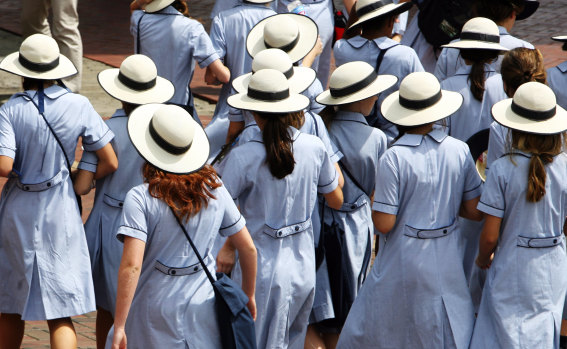This was published 4 years ago
Opinion
Give low-income parents a school choice: that's the key to equity
By Glenn Fahey and Blaise Joseph
We have to stop using private schools as a scapegoat for everything wrong with Australian education. Former NSW education minister Adrian Piccoli argued that non-government schools should receive more public funding in exchange for giving up the ability to receive fees from parents and select who they enrol.
But neither of these things are responsible for inequity. Sure, Australia’s school system suffers some inequities, but this is due to differences across postcodes rather than school sectors.

Australian parents want choice. Credit: Louie Douvis
Even if all selective, independent and Catholic schools stopped charging fees or even closed down, it would simply lead to more high-income families moving to areas with the best government schools, raising local house prices and not improving equity.
School choice reduces community "residualisation" because parents don’t have to leave the catchment if they aren’t satisfied with the local government school.
Australia is in fact more equitable – in terms of the effect of student socio-economic background on achievement and variance in outcomes within schools – than the OECD average, New Zealand and some top-performing education systems such as Singapore. This is despite Australia having one of the highest global proportions of students attending non-government schools.
High-income parents already benefit from school choice – within both the government and non-government systems – regardless of how much taxpayer funding private schools receive. But it’s low-income parents who often aren’t given a choice in Australia, and that’s the problem we should all seek to fix.
A YouGov/Centre for Independent Studies poll in 2019 found that 88 per cent of parents think their child’s school has enough resources; however, most parents also said their choice of school was limited. Those who chose non-government schools tended to be more satisfied and confident they used resources well. Put simply, Australian parents want more choice, not less.
And improving Australia’s education results – and especially outcomes for disadvantaged students – isn’t merely a matter of how much money is spent, but also how it is spent. This is an inconvenient truth for those who seek a simple solution to educational inequity – generally some combination of more taxpayer funding, curbing of non-government schools, and a shopping list of evidence-free ideas, such as more iPads.
OECD research shows Australia’s non-government schools aren’t responsible for educational inequity, and accommodate a far more diverse socio-economic makeup than in most peer countries. So, fee-charging non-government schools aren’t the cause of inequity, but what about their ability to select their students?
The proposal that all non-government schools should be publicly funded the same as government schools on the condition they give up control over their enrolments isn’t practical. For faith-based schools – especially the smaller, low-fee ones – flexibility in enrolment selection is essential in reflecting the values of their parent community.
What we need to do is expand school choice for low-income parents, not take away existing choice. While it’s suggested this can be done by reducing the autonomy of non-government schools, the better way is through creating another choice for parents, through a more flexible government school model. That is, combining the best of both worlds.
A charter school is one that’s publicly funded but privately managed – meaning parents can have greater choice without facing the burden of cost. It also means that parents have more of a say in how schools are run, rather than enduring the inflexibility of a bureaucratic government-run school system. Research from the US – where charter schools are a popular option – shows they improve educational excellence, efficiency and, yes, equity. And the main beneficiaries of expanded school choice are disadvantaged students in normal government schools.
While "competition" is often seen as a dirty word in education, the truth is having a wider range of school options – with more flexibility to cater for the needs of disadvantaged communities – can boost education results and reduce inequity.
Australia’s education results have declined on international tests over the past 10 years, despite significant increases in school spending, across sectors, and well above inflation and enrolments growth.
School class warfare isn’t going to help solve the problem. But giving low-income parents more choice will.
Glenn Fahey and Blaise Joseph are research fellows in education policy at the Centre for Independent Studies.
Get our Morning & Evening Edition newsletters
The most important news, analysis and insights delivered to your inbox at the start and end of each day. Sign up to The Sydney Morning Herald’s newsletter here, The Age’s newsletter here, Brisbane Times' here and WAtoday's here.